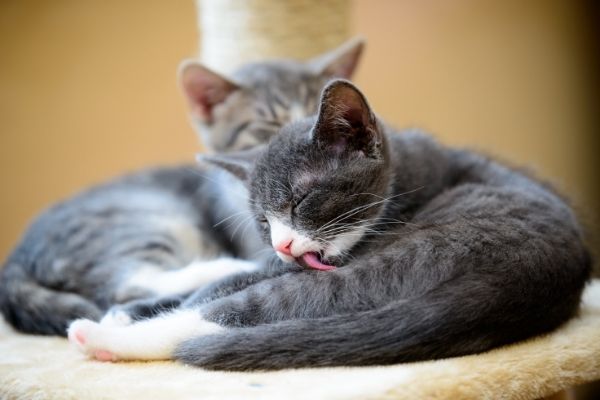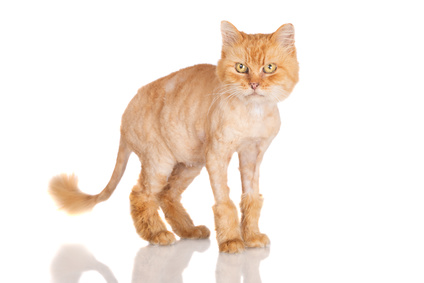Did you know that cats spend up to a quarter of their day grooming themselves?

Their rough tongues catch loose hair, which is swallowed and usually passes unnoticed through their GI tract. When a larger amount of hair has accumulated in the stomach, however, cats have a unique talent of vomiting up a trichobezoar, or “hairball” (although it’s hardly shaped like a ball).
This is protective measure that usually works just fine to rid the cat of excessive hair in its stomach. Occasionally, the trichobezoar grows so large it cannot pass out of the stomach or blocks the intestinal tract, requiring emergency surgery to remove it. Fortunately, these occurrences are rare.
Other times, cats are vomiting hairballs more frequently than normal, indicating some other underlying medical problem that needs to be addressed (besides having the carpet cleaners on speed dial).
Cats that vomit hairballs more than once a month (except in May and June, perhaps twice a month), may be grooming excessively. Or, the frequent hairballs may be a result of inflammatory bowel disease, food sensitivity, or an intestinal motility problem. It’s time to give us a call and schedule an appointment.
4 Common Remedies for Hairballs
Here are four ways to remedy hairballs.
1. Hairball diets
Over the past 15 years, “hairball diets” and “hairball treats” have become common place in the world of cat food. These diets and treats are usually higher in fiber and are thought to help cats pass swallowed hair in their stool. Whether they actually work as advertised seems to vary amongst cats.
2. Hairball Laxatives
Another common remedy is hairball laxatives, typically petrolatum-based (think Vaseline) or oil-based, that is also meant to help a cat pass swallowed hair in their stool. We suggest the oil-based hairball laxatives, but only once a week (not daily). Oil-based hairball laxatives can be harder to find than the petrolatum-based products.
3. Regular Grooming with a Cat Comb
The very best remedy for hairballs (not caused by an underlying medical problem) is regular grooming. During May and June, “regular” can mean twice a day.
Our favorite grooming tool is a nylon comb from the drugstore, or you can purchase a cat comb from a pet store. Nylon combs are inexpensive, their teeth are rarely sharp, and they can be tossed in the dishwasher to clean.
Try dipping the comb in a tumbler of water, tap it on the edge of the glass to remove most of the water, then comb your kitty in the direction the hair grows.
Most, but not all, cats enjoy grooming if it doesn’t hurt. It’s a social thing cats do for each other when they like each other. The damp comb helps pick up more hair, keeps it from flying around your home, cleans the kitty, and prevents static electricity so you don’t “zap” your cat (who would no longer find grooming much fun after that!).
It’s best to start regular grooming as a kitten so your cat, however, even many adult cats like it if you’re gentle.
 4. Lion Cuts
4. Lion Cuts
Some extra furry kitties come see us for a lion cut because their heavy coats cause them to shed A LOT.
Our nurses love doing lion cuts, and most extra furry cats like them too (however, occasionally we have to provide light sedation to accomplish the task).
Lion cuts involve clipping the fur on the trunk, but leaving the fur on the “ruff” (neck), head, legs, and tail, thus making the cat look like an adult male lion. Older cats usually act pretty kittenish after a lion cut.


